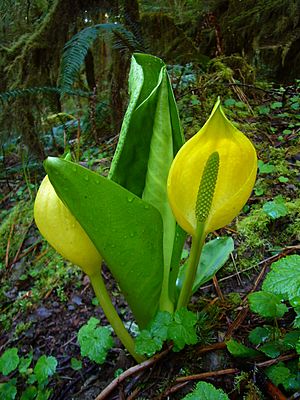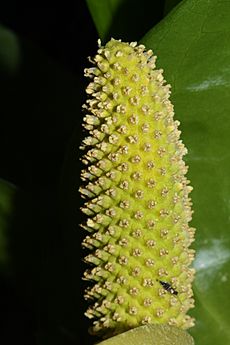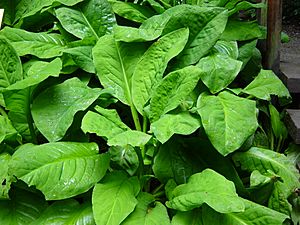Western skunk cabbage facts for kids
Quick facts for kids Western skunk cabbage |
|
|---|---|
 |
|
| Conservation status | |
| Scientific classification | |
| Genus: |
Lysichiton
|
| Species: |
americanus
|
| Synonyms | |
|
|
Lysichiton americanus, often called the western skunk cabbage, is a unique plant found in wet places like swamps, forests, and along streams in the Pacific Northwest region of North America. It's also known as yellow skunk cabbage or swamp lantern. This plant gets its "skunk cabbage" name because it releases a strong, skunky smell when it blooms. This smell helps attract its pollinators, which are mostly flies and beetles that like scavenging. Even old, dried parts of the plant can still have this distinct odor.
This plant is part of the arum family. While it shares a name and a similar smell with the eastern skunk cabbage (Symplocarpus foetidus), they are different species. The western skunk cabbage is easy to tell apart from its eastern cousin.
Contents
What Does Western Skunk Cabbage Look Like?
The western skunk cabbage grows from thick underground stems called rhizomes. These rhizomes can be over 30 centimeters (about 1 foot) long and 2.5 to 5 centimeters (1 to 2 inches) wide.
Its leaves are very large, making them the biggest leaves of any native plant in its region. When fully grown, they can be 30 to 150 centimeters (1 to 5 feet) long and 10 to 70 centimeters (4 to 28 inches) wide.
The plant's flowers grow on a special stalk called a spadix. This spadix is wrapped inside a large, bright yellow or yellowish-green leaf-like structure called a spathe. The spathe is about 7 to 12 centimeters (3 to 5 inches) long and sits on top of a stalk that is 30 to 50 centimeters (1 to 1.5 feet) tall. Many small flowers are packed tightly together on the spadix.
Western skunk cabbage is one of the first plants to bloom in late winter or early spring. You might see its bright yellow spathes even when there's still snow on the ground! Unlike some other skunk cabbage plants, the flowers of Lysichiton americanus do not produce heat, even though some people mistakenly believe they do.
Where Does Western Skunk Cabbage Grow?
You can find Lysichiton americanus naturally in many parts of western North America. It grows from Kodiak Island and Cook Inlet in Alaska, south through British Columbia, Washington, Oregon, and Northern California. It can be found as far south as Santa Cruz County. There are also smaller groups of these plants in northeastern Washington, northern Idaho, Montana, and Wyoming.
This plant was brought to the United Kingdom in 1901 to be grown in gardens. However, it has since spread and now grows wild in marshy areas across Britain and Ireland. For example, you can find it in places like Hampshire and Surrey, including Wisley Gardens. In 2016, the European Union officially listed it as an invasive non-native plant species. This means it can sometimes harm local plants and ecosystems where it isn't native.
Growing Western Skunk Cabbage
In the past, western skunk cabbage was grown as an ornamental garden plant in Britain and Ireland. It grows very well in wet, marshy conditions. However, because it has become an invasive species in these areas, the Royal Horticultural Society recommended in 2018 that people should not grow it anymore.
There are also hybrid plants, which are a mix of Lysichiton americanus and another species called Lysichiton camtschatcense. These hybrids are known as Lysichiton × hortensis. They are sometimes grown in gardens and have even larger spathes than their parent plants.
Other Ways Western Skunk Cabbage Is Used
While some people might see western skunk cabbage as a weed, it actually has some interesting uses in nature. Its roots are a food source for bears, especially after they wake up from hibernating. Bears eat the roots to help clean out their digestive system. Deer also sometimes eat the leaves of the plant.
Indigenous people historically used this plant for both medicine and food, especially during times when other food was scarce. They used it to help treat burns and injuries. The leaves were sometimes heated and eaten, and they have a slightly spicy or peppery taste.
However, it's important to know that the plant contains tiny crystals called calcium oxalate. If eaten in large amounts, these crystals can cause a prickling feeling in the mouth and throat, and might upset your stomach. Because of this, the plant was not usually a regular part of their diet.
Even so, the large, waxy leaves of the western skunk cabbage were very useful for preparing and storing food. They were often used to line baskets for berries or to wrap around whole salmon and other foods before baking them under a fire. The plant was also used to help heal sores and reduce swelling.
See also
 In Spanish: Lysichiton americanus para niños
In Spanish: Lysichiton americanus para niños




